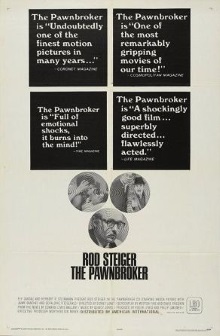
After having watched so many films, I’d like to think that I’m starting to have a good grasp of what is out there even if I haven’t necessarily watched it yet, especially when it comes to American cinema. But every once in a while I’m reminded that there’s so much that I still don’t know. I’d never heard of Sidney Lumet before this but he is apparently one of the most respected American directors of all time with an impressively long filmography and a reputation of being a great craftsman of film.
The Pawnbroker isn’t only one of Lumet’s best films, it was also precedent setting in a couple of ways: it was the first American film to deal with the Holocaust from the point of view of a survivor and it was one of the first films to include nudity while the Hays Code was still in effect. The eponymous character is Sol Nazerman, a concentration camp survivor. After losing his entire family n Germany, he is now a pawnbroker in New York. But as revealed through his interactions with his customers and his employee Jesus Ortiz, even though he is alive, he has deadened himself to all emotions and has become so bitter that he regards all humans as scum.
Nazerman never speaks to anyone about his experience and most of the people he interacts with don’t even realize that he was a concentration camp survivor. One particularly horrifying moment is when Ortiz notices the number tattooed on his arm and comments about how cool it looks. The audience is shown some of what he’d lived through in the form of flashbacks that are intercut with the present and the fact that these are always purely visual without any dialogue whatsoever adds greatly to their effectiveness. Even these visuals are surprisingly restrained. The film never has any graphic depictions of Nazi atrocities but the mere suggestion of them and Nazerman’s pained reactions to those memories are more than enough to hit you hard in the gut.
One way in which The Pawnbroker distinguishes itself as a great film rather than a merely good one is how its multiple motifs and themes overlap and mutually reinforce one another in an effortless seeming manner. Nazerman has a regular stream of customers who come to him offering the detritus of their lives for a pittance, their desperation and lack of alternatives evident on their faces. The parallel with the Jews’ helplessness during the Second World War is obvious and the great tragedy is that he is indifferent to it. Another great moment is when Nazerman rips into the pain and sacrifice that lies behind the Jewish reputation for business acumen in one explosive burst that leaves Ortiz in shock. Even the setting itself is used to great effect. Nazerman’s pawnshop is in the middle of Harlem and Lumet takes care to depict how lively and energetic it is, the better to contrast with how Nazerman is inside.
The camera work is exquisite and each image is composed and framed so beautifully that they could each be an individual work of art. In fact the shots of the streets of New York, complete with throngs of pedestrians moving about, are so high quality that I can believe this film is valuable for the purposes of historical preservation. Rod Steiger’s performance as Nazerman, a German-Jewish professor before the war, is so perfect that one can hardly believe that Steiger was born and raised in New York City. From moment to moment, his face shifts between disdain, anguish and a terrible vulnerability. The film as a whole has a kind of seriousness and aesthetic purity that makes it feel very different from other American films of that era. It feels more like a continental European film and indeed Lumet was apparently influenced by the French New Wave movement.
It’s always more difficult to write about really great films than about bad ones, one reason why this post is so short. Great films simply stand out so much that their excellence seems almost self-evident and even a casual comment can feel like belittling its achievement. This is doubly true for The Pawnbroker, a film that grapples with the singular and overwhelming horror that is the Holocaust on a deeply individual and personal level. One measure of how good it is can be seen in that the censors granted it a special one-time exception to rules against nudity to allow it to be shown. In short this is a masterpiece that deserves to stand alongside the best films of American cinema but is often overlooked by contemporary critics.
One thought on “The Pawnbroker (1964)”